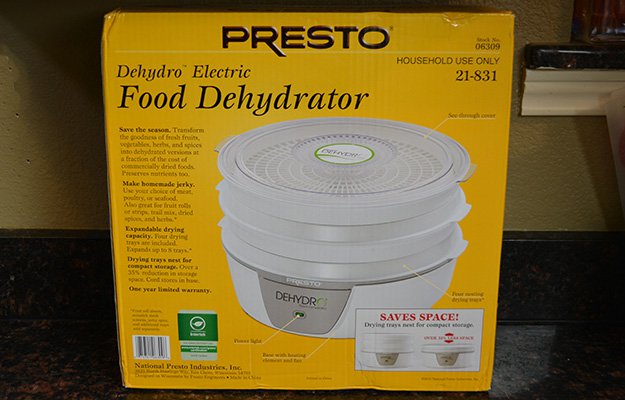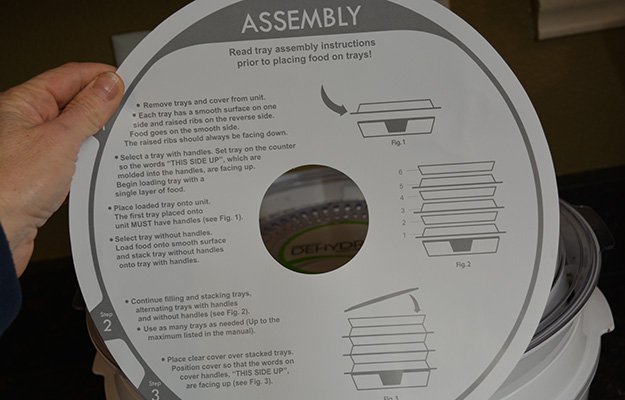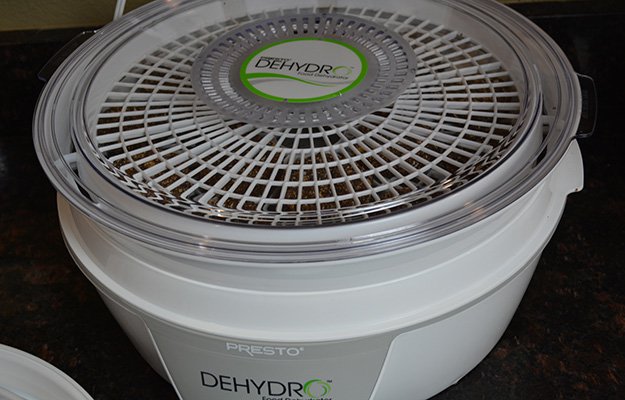Food Storage
Long Term Food Storage – Our Favorite Dehydrator

Ever wanted to try dehydrating things for long term food storage?
You will need a food dehydrator of some sort. I recommend starting with a pretty basic one when you first try your hand at this. You do not need anything terribly fancy.
The basics of food dehydration are simple. You need equipment that allows you to effectively remove all moisture from your food so it will store optimally.
Why would I want to dehydrate food, anyway?
Food dehydration or drying has been around for centuries. It is one of the oldest methods of preserving food. Canning and freezing foods will retain more nutrition than dehydrated foods, but dehydrated foods are space efficient and weigh far less. I find it much easier to dehydrate foods than it is to can them.
Dehydrating food is great for people who like to hike and camp because it often reduces the weight of a given food from 50 to 90 percent.
Dehydrated fruits and vegetables make great healthy snacks. I like to use them in recipes as well.
I did not know you could easily dry herbs in a dehydrator. I had been hanging my herbs to dry for years. Now, I can just clip them from the garden and toss them right in the dehydrator trays.
What can you dehydrate or dry?
So far, I have dried beef jerky, chocolate chia survival bars, strawberries, blueberries, tomatoes and some herbs from my garden. All were simple to do. You just turn the machine on for the time specified in the instructions, and turn off when finished. I was quite pleasantly surprised to see how easy it was to dry and dehydrate food.
Do you have a starter model you recommend?
Yes. The Presto Dehydro food dehydrator is the simplest basic version I found that I really like. It was by far the easiest to use out of the box. The instructions that come with it make set up simple, directions as well as uses are clearly spelled out with nicely presented instructions.
I think this food dehydrator is perfect for those just starting with drying and dehydrating food for survival food storage.

This is the box for the product, and I like the way it is packaged. This is a basic dehydrator that you can easily set up and use in minutes.
Easy Set Up
This dehydrator has clearly labeled parts and clear instructions that accompany the kit. I really appreciated the paper insert that was in the dehydrator when I opened it. This provided a quick set up guide, with an easy to follow diagram.

This handy diagram comes with the machine, showing you how to quickly and easily set up the trays to dry food.
Clear Instructions
The instructions that come with the Presto Dehydro Food Dehydrator not only tell you how to use the machine, they tell you what you can make with it. A chart with drying times for a wide variety of foods is included, as are instructions for drying particular foods.

This is what comes with the Presto Dehydro Food Dehydrator. The round insert included with it makes set up easy.
For example, the instructions explain how to prepare fruits before drying. It turns out you need to put blueberries in boiling water briefly before you dry them. Without these instructions, I would have thrown my blueberries right in.
Multitude of Uses
I was happy to read this model also accommodates different trays, so that you can use it to dry fruit rolls and other specialty items. You order these separately, which I plan to do soon.
Try DIY Ready’s homemade beef jerky in your dehydrator:
Also try the DIY Ready recipe for Chocolate Chia Survival Bars that you can dehydrate:
Survival Bar Recipe and Instructions: Chocolate Chia Survival Bars
Want to try this dehydrator?
Here is where you can get one:
Presto 06300 Dehydro Electric Food Dehydrator
There are also cool accessories for this product, like trays that allow you make fruit rolls:
National Presto Dehydro Electric Food Dehydrator Fruit Roll Sheets
Nonstick screens for small food items like berries, or ones that might stick:
Presto 06307 Dehydro Electric Food Dehydrator Nonstick Mesh Screens
The Groundfridge: Changing the Face of Food Storage
How to Store Food Using Oxygen Absorbers
Food Storage Solutions: Buckets, Lids and Gamma Seals
-

 Do It Yourself7 months ago
Do It Yourself7 months agoParacord Projects | 36 Cool Paracord Ideas For Your Paracord Survival Projects
-

 Do It Yourself9 months ago
Do It Yourself9 months agoHow To Make Paracord Survival Bracelets | DIY Survival Prepping
-

 Do It Yourself9 months ago
Do It Yourself9 months ago21 Home Remedies For Toothache Pain Relief
-

 Do It Yourself10 months ago
Do It Yourself10 months agoSurvival DIY: How To Melt Aluminum Cans For Casting
-

 Exports8 months ago
Exports8 months agoAre Switchblades Legal? Knife Laws By State















Mark
February 21, 2014 at 11:16 AM
I have been using an “entry level” dehydrator for about 20 years, these days I use it mostly for making venison jerky. 2 hints, spray a little PAM or wipe a little oil on the trays first, makes clean-up a cinch. When I make jerky out of ground instead of sliced it is very “wet” so to prevent it from sagging through I cut some vinyl window screen to put on the tray before the jerky, works great!
elisabeth
February 21, 2014 at 12:50 PM
Thanks for the tips, Mark! (I’m kicking myself that I didn’t think of spraying with Pam on my own, heh). We do a lot ground jerky (also known as “meat candy” in our house); it rarely lasts the week, much less saving it for long-term storage!
Denise
February 23, 2014 at 8:26 PM
I have been drying for years and find it an awesome way to store your abundance. I highly recommend the Excaliber dehydrater. It is a larger machine for bigger projects(but it also comes in a smaller size as well) and it really allows you to better control the heat and air flow. I also found a web page I highly recommend for beginners..Dehydrate2store.com. It has a tremendous amount of useful information. If you happen to have chickens – eggs can be dehydrated and put in vacume seal bags to last a long time.
Jan
March 12, 2014 at 3:36 AM
Thanks for sharing this. Food dehydrating is really cool. I love it because I can stack up on goodies in case something bad happens. I believe there are several other brands that are just as good. But I heard that this one performs well too. I should go and try it some time.
Pingback: highest long run food Storage tips | Man Shaved / Best Electric Shaver
Pingback: Emergency Food Storage Fails | Survival Life - Survival Life | Preppers | Survival Gear | Blog
Pingback: Emergency Food Storage Fails | Pioneer Settler | Homesteading | Self Reliance | Recipes
Mick
August 14, 2014 at 5:04 AM
Great info–thanks! Please tell us which vacuum sealer pairs well with this dehydrator?
Trish
August 24, 2014 at 3:50 AM
This is wonderful information. I’ve been experimenting with my dehydrator machine for a year now but want to get more proficient.
I use my machine mostly to dehydrate sweet potato slices. They make tasty snacks and are much lest costly than store-bought snacks. And what we drop on floor, doggie loves to clean up!!!
I’m growing pie pumpkins this year in garden. Can I dehydrate them? How do I prep them for dehydration? In past I baked pumpkin and scraped meat off skin and mashed and froze results. If I dehydrate, can I re-hydrate to make mash? Or should I just learn canning?
Pingback: Survival Food Dehydrator | Extreme Survival Guide
Pingback: Emergency Food Storage Fails - Survival Skills America
Pingback: The Groundfridge: Changing the Face of Food Storage
Pingback: How To Preserve Your Summer Harvest | Survival Life
Pingback: Top Uses of Rechargeable Lithium-Ion Batteries | Best Go Bag
Pingback: The Best Foods to Dehydrate to Survive Long Term - Health and Fitness